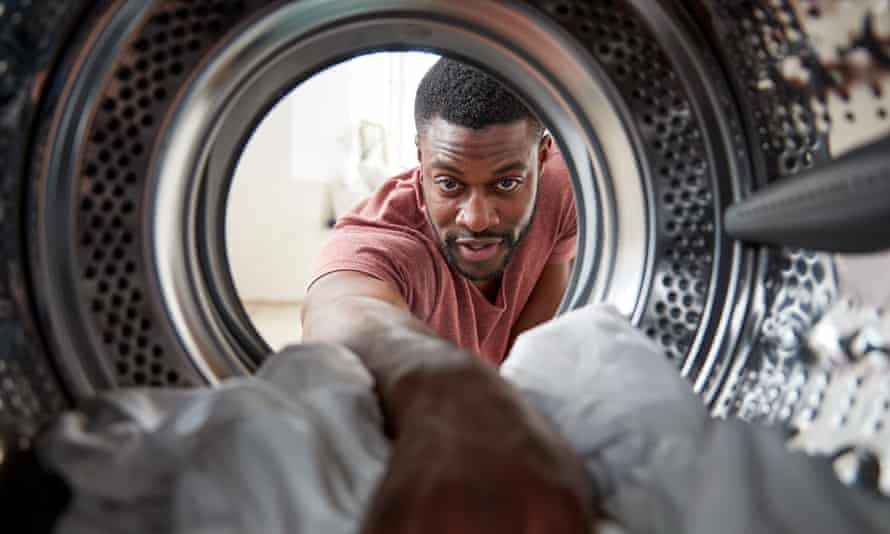
There is something extremely satisfying about pulling a load of warm, fresh laundry out of a clothes dryer. But as a general rule, if you have the time, space and weather to dry your laundry on a clothesline, you should. It is energy efficient, cheaper and much gentler on your clothes.
But as line drying is not always practical or possible, experts here explain the nuances of using a clothes dryer.
To tumble or not to tumble
It might seem obvious, but when deciding what you can put in the dryer be sure to refer to the care label. Gina Dimakopoulos, the manager of appliance store Hart and Co, says “you have to follow the guidelines of the clothing you have”.
Generally speaking, harder wearing cottons and some polyester blends should be OK to tumble dry, but for other fibres it will depend on the finishes and treatments applied during the garment’s production.
The heat and agitation in the dryer can damage clothes in a variety of ways, from causing elastane to age and lose its stretch, to shrinking wool and other delicate materials. So reading care labels is very important.
The price to pay
Given the current state of the energy market, it’s important to note that some clothes dryers use a lot of energy and can drive up your bills.
According to Alan Pears, a sustainable energy and climate policy activist, “a typical dryer uses over three kilowatt-hours per load and rates two stars on the energy label”. He says, “at pre-July prices [this was] around 75 cents” per load.
Pears is referring to the most common type of clothes dryer, a vented dryer. There are two other types of dryers on the market: heat pump and condenser. Each one uses different technology and consumes resources in different ways.
The least efficient
Ashley Iredale, a white goods expert from the consumer platform Choice, says “vented dryers are just a big box with a fan, heater and motor in them to rotate the drum”. They are called a vented dryer because they have an exhaust that blows out the resulting moisture, so they need to be attached to a vent to prevent condensation from building up inside the house.
Although they cost more to run, vented dryers are cheaper to buy. So, Iredale says, if you will use your dryer infrequently, a vented model may end up being more cost effective. Plus, he says vented dryers tend to last longer than more efficient dryers like heat pump dryers, “because there’s simply nothing in them to break”.
The most efficient
Every expert I spoke to said that although heat pump dryers are more expensive to buy, they are the most efficient dryers to run. They work by blowing hot air while removing the moisture from your laundry.
Pears says because heat pump dryers “extract and recycle the heat from the exhaust air” they use one-third of the electricity a vented dryer would, and sometimes even less. They also catch the water that condenses in a container so they don’t cause condensation problems.
And the other one
Pears says condenser dryers “are about as inefficient as traditional dryers”. They work by drawing the moisture from your clothes and converting it into water that is stored within the machine until you empty it. But, since they rely on water from a tap to condense the water vapour in the exhaust air, they consume a lot of water for cooling, which makes them even less resource-efficient. Iredale says this is the technology used in washer-dryer units.
How to choose the right one
Pears recommends using the government’s star rating label to understand how efficient each machine is. There’s also an app that helps you compare the performance of different models.

Your choice might also be dictated by the space and ventilation in your laundry. For example, condenser and heat pump dryers are too heavy to be bolted to the wall like a vented dryer, so they may need to be stacked on top of your washing machine. If you have a laundry with poor ventilation, you’ll want to opt for a condenser or heat pump dryer to avoid condensation building up inside.
How to run a dryer efficiently
Every drop counts, so start by using the highest spin speed on your washing machine, Iredale says. “The more water you can extract … the less work the dryer has to do.” Be mindful, though, of putting delicates through a high-speed spin.
Then sort your clothes into weight or fabric type to be sure you are drying like with like. “If you put very fine items in with heavy towels and denim then the lighter stuff will dry much faster and can become over-dry and damaged,” he says.
Sign up to receive Guardian Australia’s weekend culture and lifestyle email
“To be sold in Australia, a dryer must be able to get its contents down to 6% or lower residual moisture content,” Iredale says, so you should trust that your clothes are dry at the end of the drying cycle.
Finally, make sure you don’t overload your dryer so your laundry has enough room for the air to circulate evenly.
Other considerations
Dimakopoulos says there are some overlooked features common to most dryers that can give you better results. She recommends the steam finish function because it relaxes the fibres, which allows for less ironing and can help your clothes last longer.

Iredale is a fan of reverse tumbling. To ensure your laundry doesn’t end up tangled in a ball, he also likes the anti-wrinkle function, which “tumbles the clothes at regular intervals after the drying’s finished to prevent creases”.
If you don’t know how to find these settings on your dryer, reading your dryer’s instruction manual, as tedious as it might be, should help clarify what the buttons and symbols mean. If you’ve lost the manual, a quick online search including the brand name and model should reveal some instructions.
Caring for your dryer
A clean lint filter is the most important aspect of dryer care, Iredale says, and this should be done after every use. “Lint buildup is a fire risk but it also obstructs airflow, so your dryer has to work harder and will cost you more to run.”
Lint isn’t the only fire risk. “Don’t put flammable materials or clothes soaked in solvents or accelerants in the dryer either,” Iredale warns. And don’t run the dryer when you’re not home.
Finally, he suggests leaving the dryer door ajar between cycles as this helps the seals maintain their shape.



